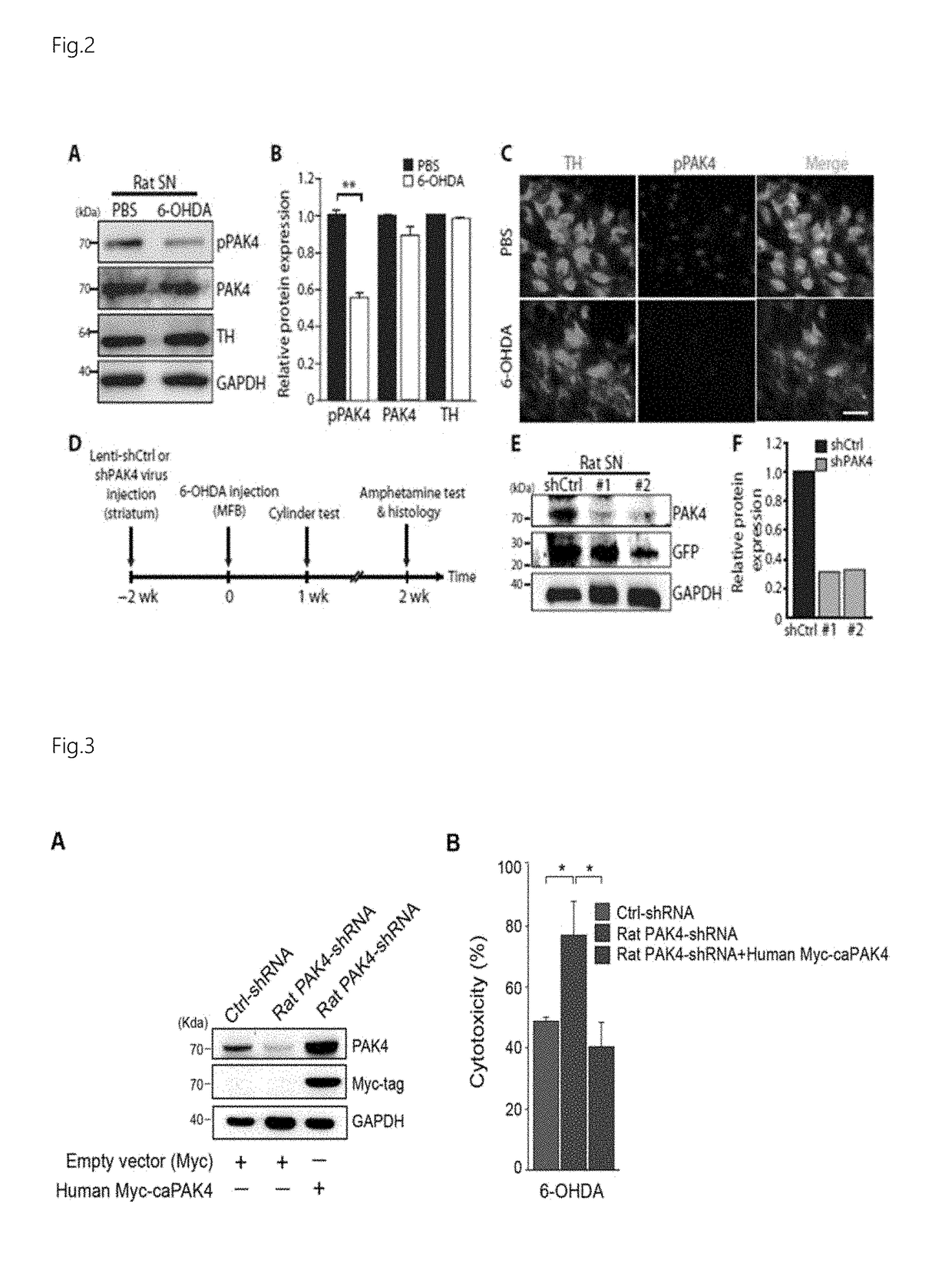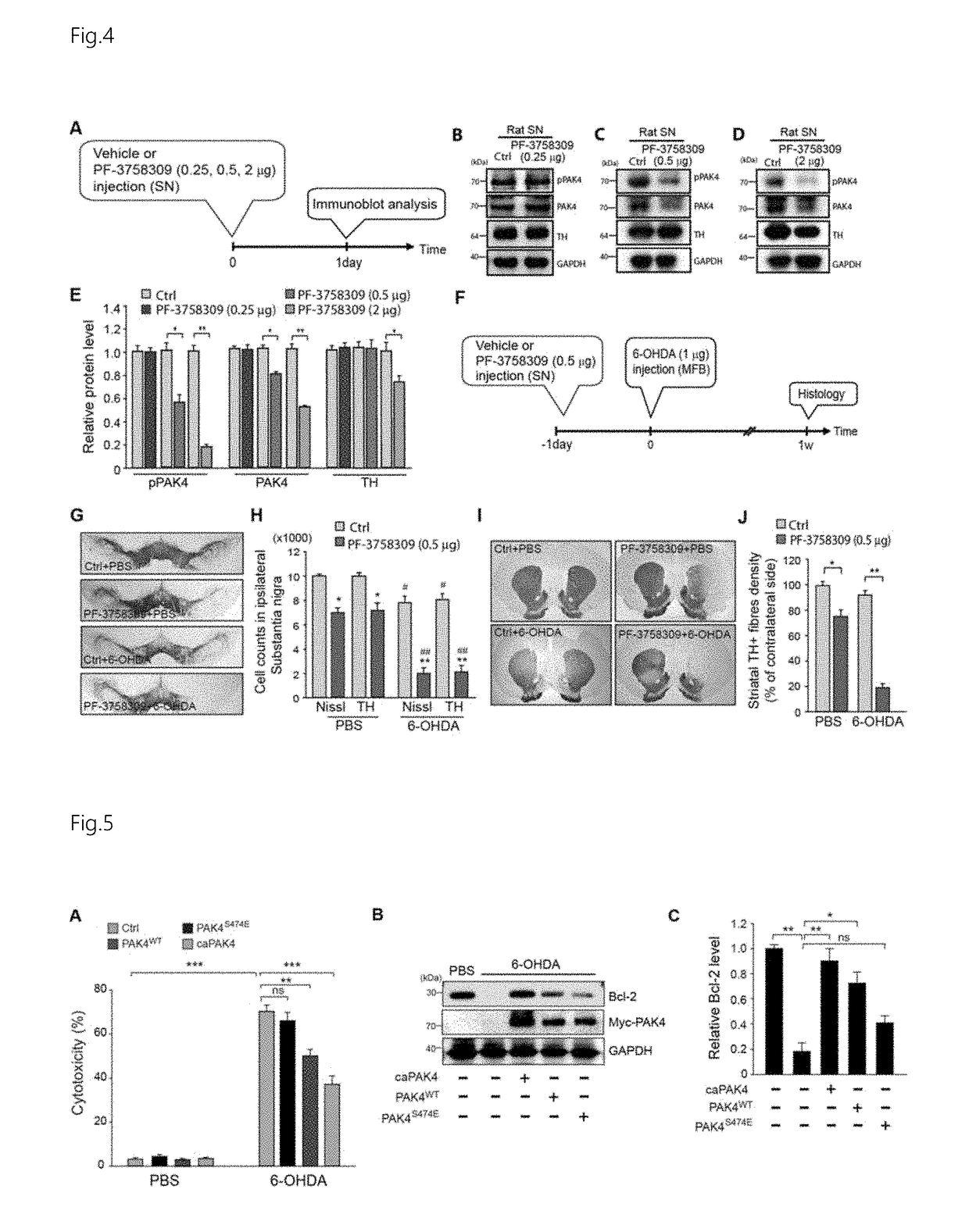Use of pak4 and crtc1 for treatment or diagnosis of brain degenerative disease
- Summary
- Abstract
- Description
- Claims
- Application Information
AI Technical Summary
Benefits of technology
Problems solved by technology
Method used
Image
Examples
preparation examples
[0088]Materials and Experimental Methods
[0089]The commercial sources of the materials used in the following experiments and the experimental methods are as described below. In addition, the samples from patients with Parkinson's disease used in the experiments were obtained from Victoria Brain Bank Network (VBBN), and the experimental methods were conducted under the conditions approved by the Ethics Review Committee of the Institutional Review Board of Chungbuk National University (approval number: CBNU-IRB-2011-T01).
[0090]Also, the rats used in the experiments were 260 to 280 g of Female Sprague-Dawley rats obtained from Taconi, and kept under 12-hour light / dark cycles while being fed a normal diet. Animal experiments were also conducted under the conditions approved by the Ethics Review Committee of Chungbuk National University for Animal Experiments (approval number: CBNUA-400-12-02).
[0091]In addition, the human tissues used in the experiments were obtained from VBBN, and all ex...
example 1
[0140]Analysis for Neuroprotective Activity of PAK4 in Parkinson's Disease
[0141]Expression levels of pPAK4 and PAK4 in Parkinson's disease were analyzed. As for samples for analysis, the tissue samples obtained from the subjects for experiments in Table 1 above were immunoblotted with pPAK4 and PAK4 antibodies.
[0142]As a result, as shown in FIG. 1, it has been shown that expressions of pPAK4 and PAK4 were all reduced in the samples derived from patients with Parkinson's disease compared to the control samples. In addition, it has been shown that the expression level of TH, a marker of DA neurons, was also reduced in the Parkinson's disease group compared to the control group (see FIGS. 1A and 1B). Besides, the expression levels of pPAK4 and PAK4 in living TH-positive DA neurons were analyzed. As a result, it has been shown that the expression in DA neurons of the Parkinson's disease group was reduced compared to the control groups (age-matched control, young control) (see FIGS. 1C t...
example 2
[0143]Analysis of Expression Levels of PAK4 and Phosphorylated-PAK4 in Animal Model of Parkinson's Disease
[0144]After each brain tissue was obtained through the experimental procedure as described above in the rat animal model of Parkinson's disease induced by administration of 6-OHDA, the expression levels of PAK4 and phosphorylated-PAK4 were analyzed.
[0145]As a result, as shown in FIG. 2, it has been shown that the expression level of phosphorylated-PAK4 was significantly reduced in the samples from rats with Parkinson's disease induced by 6-OHDA, compared to the control without 6-OHDA administration (see FIGS. 2A to 2C).
PUM
 Login to View More
Login to View More Abstract
Description
Claims
Application Information
 Login to View More
Login to View More - R&D
- Intellectual Property
- Life Sciences
- Materials
- Tech Scout
- Unparalleled Data Quality
- Higher Quality Content
- 60% Fewer Hallucinations
Browse by: Latest US Patents, China's latest patents, Technical Efficacy Thesaurus, Application Domain, Technology Topic, Popular Technical Reports.
© 2025 PatSnap. All rights reserved.Legal|Privacy policy|Modern Slavery Act Transparency Statement|Sitemap|About US| Contact US: help@patsnap.com



